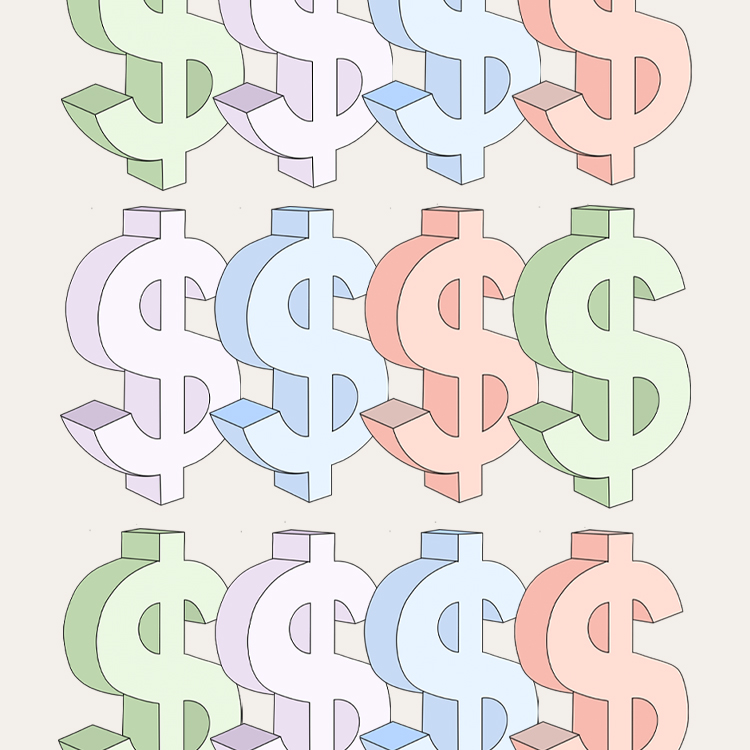
When’s the last time you took inventory of your finances—not a quick glance at your bank account balance but an in-depth review of your spending habits, earning goals, and investment opportunities? Financial literacy can sometimes fall to the wayside with all of our many responsibilities, but it’s truly the foundation of our lives. After all, financial decisions are the basis of most life decisions. Financial literacy can mean many things, and the National Financial Educators Council defines financial literacy as “possessing the skills and knowledge on financial matters to confidently take effective action that best fulfills an individual’s personal, family and global community goals.” Emphasis on the skills and knowledge.
Money is a taboo topic in our society, especially among women, but we’re breaking the ice on that and opening ourselves up to financial decisions that make dollars and sense. A good way to start making better financial decisions is by becoming aware of earning, saving, investment, and spending (!) options that benefit your bottom line. No matter your current financial situation, these tips will help get you closer to a healthy financial place, whatever that means for you!
Ditch Limiting “Money Rules” and Reclaim Your Relationship with Your Finances
There are so many arbitrary “money rules” that affect our inter- and intrapersonal relationships with money. They are cardinal money sins, rules that must never be broken, like men being the financial breadwinners or women accepting salary offers without negotiating. These are just a couple of common “rules,” and you can probably think of more based on your own personal experiences. Despite societal limitations, women are in the best position to shatter these rules because we make 90% of household financial decisions, meaning we have the greatest impact on our own finances and those of our loved ones. As women, it’s critical that we leave these dated, unnecessary rules in the dust because they have never benefited us, and in fact, our obedience to them costs us in major ways. On average, women earn 86 cents for every dollar men earn. This adds up to about $900,000 over a 40-year career. That’s almost $1 million of unearned money. We’re leaving funds on the table, ladies, and it’s time for us to be more vocal and vigilant about our financial potential.
Identify Your Financial Goals
Saving for a new car? Making a career move that comes with a different salary? Planning for retirement or starting a family? Investing in NFTs or other cryptocurrency? These are each very real financial decisions that should involve strategic planning and deliberate preparation. But you can’t be strategic or deliberate about your financial decisions until you assess how the decisions impact your overall financial goals. Financial institution Charles Schwab releases an annual modern wealth index that polls Americans about their money habits and financial plans. The index categorizes goals into financial comfort, financial happiness, or financial wealth. Your individual lifestyle and how you define these terms will determine which goal you aim for. But whichever goal you choose, it’s your goal, and any financial decision you make should be in alignment with your goal. Knowing and being comfortable with your financial goals is really the first step in changing your financial situation. You have to know where you are in order to get to where you’re going.

Source: ANTONI SHKRABA production | Pexels
Put Your Financial Plans in Writing
According to Charles Schwab, only 33% of Americans have a written financial plan. This is a huge lost opportunity for the other 77% of Americans because people who have their financial plans written down have better financial outcomes. When it comes to feeling financially stable, having an emergency fund, never carrying a credit card balance, and considering investment options, people with a plan fare better by at least 25%. Having your financial plan in writing is as important as having your personal goals in writing. There’s something about seeing the words on paper (or screen) that makes it more real. Of the 77% of Americans without a written financial plan, 42% say it’s because they don’t think they make enough money to need one, but this is a misconception. Even if you live paycheck to paycheck and there’s little room in your budget for anything extra, planning what you do with the funds available to you will help you see where your money is going, where you can cut costs, and which parts of your plan could use some strengthening. Don’t underestimate the power of the pen!
Be Strategic About Debt and Credit Use
Using credit can quickly become a slippery slope. As if actual credit cards weren’t enough, now we have things like Klarna and Afterpay that allow us to buy now and pay later (no shade to credit companies, Klarna, or Afterpay). The immediate gratification of credit use can feel pretty good, but it’s getting stuck on those buying rushes that can lead to trouble. Debt isn’t necessarily bad, and if used wisely, it can enhance your financial options. The keys are having access to funds and intentional payment timing. If the amount of what you buy is more than the money you actually have, you will be in a deficit. This isn’t a good place to be, and depending on how far into deficit you get, it can be very difficult to get out. Remember that with most credit, you owe the amount that you spent plus a percentage of interest on that amount. The larger balance you have, the more money you spend on interest. Not only should you have the funds available to pay all or most of what you’ve charged on credit, but you should also time payments according to your billing cycle. For example, if you make payments before interest is calculated on your balance, you’ll pay less in interest and more of your payment will go toward your actual balance. You’ll also have more credit available to you this way since the amount you owe on the principal balance will be less, and you’ll be debt-free quicker if that’s one of your goals. This will likely mean making payments before your scheduled due date. If you’re in the financial position to make early payments on credit card debt, it’s not a bad option to consider.
Look for Easy Investment Options
Investing can be intimidating. There are countless investment options with varying rates of opportunity and loss, and it can be challenging to decide which options carry the least risk. For those who have little disposable income to work with, even the smallest risk might be too daunting. Still, by changing your way of thinking and reaching for low-hanging investment fruit, investing could make a significant difference in your financial situation. The strength of our investments depends on how others are investing, which causes performance fluctuations. However, there are some “safe” investment options that are minimally impacted by fluctuations and carry less of a risk. If your company offers a 401(k) retirement plan, make sure you are enrolled. The plan will take a percentage of your check and put it in an investment account that you can draw from once you retire. Many companies will match a certain percentage of your contribution, which is basically free money going into that account. The delayed gratification of having a large sum available to you once you’re no longer working will be enormous, but if you absolutely need to access your 401(k) funds early, you can. There are penalties for early withdrawal and the IRS will tax the funds as income, but if you’re in a pinch and need money, it’s a nice plan B to your plan B. Remember, though, that it takes time for the funds to add up, so don’t expect to have a substantial amount available if you haven’t been contributing to the plan for very long. Other “safe” investment options include U.S. Treasury bonds, purchasing stock options in publicly traded companies, and purchasing property to rent or list for temporary stays.

Source: ELEVATE | Pexels
Talk About Money Like You Talk About Anything Else
We’ve all heard it before: Never discuss your salary or earnings. It’s “unladylike” to talk about money. How much you earn is not anyone’s business. These are just a few sentiments that contribute to women’s tendency to be uncomfortable with having conversations about money. There are other reasons behind the general discomfort that are extremely valid, but there is room to loosen the reins a bit and start having discussions that advance our financial goals without being intrusive. Try having light and optimistic financial conversations with friends, trusted coworkers, or family members: “You’ve been working so hard on this project! Have you considered asking for a pay increase?” “I’m setting money aside for my emergency fund, so I can’t make the trip this time.” “I haven’t treated myself in a while, so I bought [insert item/service] as self-appreciation!” Avoiding specific amounts, clearly articulating goals, and encouraging financial enjoyment are easy ways to incorporate money into your conversations.
Build Your Financial Baseline and Use Resources for Support
There are an endless amount of stigmas around money and finances. As women, we experience many of those stigmas first hand, impacting our financial potential. Beyond the gendered notions of finances, regional, cultural, and even familial differences impact our relationships with money, too. The thing is, many of us want to have better relationships with money, and there is always room for improvement. Fortunately, financial relationships are one of the most personal relationships we have with ourselves, so that means it’s ongoing and constantly evolving. As we move through life’s changes, our finances flow with us. Just like any relationship, we have high seasons and low seasons, so it’s critical to have a sturdy baseline that puts you in the best financial position with any given situation. Your “best financial position” is relative and might look different now from how it looked in the past or how it will look in the future. That’s why your baseline is so important.
Once you have your baseline established, you can explore financial options with a financial adviser or wealth management planner (bonus tip!), who can develop strategies and recommendations that are specific to your situation. If you’re struggling with even identifying your financial baseline, a financial planner could help you with that too. Many financial professionals offer complimentary consultations, and some of their regular services are even free! Taking advantage of your resources is everything; you just have to look into what some of those resources are. Now that you have these tips and next steps, go get to the money!
